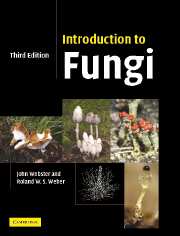Book contents
- Frontmatter
- Contents
- Preface to the first edition
- Preface to the second edition
- Preface to the third edition
- Acknowledgements
- 1 Introduction
- 2 Protozoa: Myxomycota (slime moulds)
- 3 Protozoa: Plasmodiophoromycota
- 4 Straminipila: minor fungal phyla
- 5 Straminipila: Oomycota
- 6 Chytridiomycota
- 7 Zygomycota
- 8 Ascomycota (ascomycetes)
- 9 Archiascomycetes
- 10 Hemiascomycetes
- 11 Plectomycetes
- 12 Hymenoascomycetes: Pyrenomycetes
- 13 Hymenoascomycetes: Erysiphales
- 14 Hymenoascomycetes: Pezizales (operculate discomycetes)
- 15 Hymenoascomycetes: Helotiales (inoperculate discomycetes)
- 16 Lichenized fungi (chiefly Hymenoascomycetes: Lecanorales)
- 17 Loculoascomycetes
- 18 Basidiomycota
- 19 Homobasidiomycetes
- 20 Homobasidiomycetes: gasteromycetes
- 21 Heterobasidiomycetes
- 22 Urediniomycetes: Uredinales (rust fungi)
- 23 Ustilaginomycetes: smut fungi and their allies
- 24 Basidiomycete yeasts
- 25 Anamorphic fungi (nematophagous and aquatic forms)
- References
- Index
- Plate section
22 - Urediniomycetes: Uredinales (rust fungi)
- Frontmatter
- Contents
- Preface to the first edition
- Preface to the second edition
- Preface to the third edition
- Acknowledgements
- 1 Introduction
- 2 Protozoa: Myxomycota (slime moulds)
- 3 Protozoa: Plasmodiophoromycota
- 4 Straminipila: minor fungal phyla
- 5 Straminipila: Oomycota
- 6 Chytridiomycota
- 7 Zygomycota
- 8 Ascomycota (ascomycetes)
- 9 Archiascomycetes
- 10 Hemiascomycetes
- 11 Plectomycetes
- 12 Hymenoascomycetes: Pyrenomycetes
- 13 Hymenoascomycetes: Erysiphales
- 14 Hymenoascomycetes: Pezizales (operculate discomycetes)
- 15 Hymenoascomycetes: Helotiales (inoperculate discomycetes)
- 16 Lichenized fungi (chiefly Hymenoascomycetes: Lecanorales)
- 17 Loculoascomycetes
- 18 Basidiomycota
- 19 Homobasidiomycetes
- 20 Homobasidiomycetes: gasteromycetes
- 21 Heterobasidiomycetes
- 22 Urediniomycetes: Uredinales (rust fungi)
- 23 Ustilaginomycetes: smut fungi and their allies
- 24 Basidiomycete yeasts
- 25 Anamorphic fungi (nematophagous and aquatic forms)
- References
- Index
- Plate section
Summary
Urediniomycetes
Following extensive re-arrangements, the class Urediniomycetes (about 8000 species) is now considered to be monophyletic, although the naming of orders and families is still proving difficult (Swann & Taylor, 1995; Kirk et al., 2001; Swann et al., 2001). The order Uredinales (rust fungi) is by far the largest (about 7000 species) and the most important. The order Microbotryales, although taxonomically part of the Urediniomycetes, is a group of fungi causing smut diseases and will be discussed in Chapter 23. Many Urediniomycetes belonging to several orders occur predominantly in the yeast state. An important group, the Sporidiales, contains the red yeasts Sporidiobolus and Rhodosporidium (anamorphs Sporobolomyces and Rhodotorula, respectively), and this order is considered in more detail on pp. 666–670.
General information on the groups included in the Urediniomycetes has been given by Swann et al. (2001). They have defined Urediniomycetes as fungi in which the processes of karyogamy and meiosis occur in distinct parts of the basidium, i.e. the probasidium and metabasidium, respectively. The metabasidium is typically transversely septate, with basidiospores produced laterally (see Fig. 22.2d). Another useful character is the structure of septa viewed by transmission electron microscopy. Urediniomycete septa are simple with a single pore which may be open or plugged, but they typically lack the dolipore arrangement found in other basidiomycetes (see Fig. 18.9). Clamp connections are absent.
Information
- Type
- Chapter
- Information
- Introduction to Fungi , pp. 609 - 635Publisher: Cambridge University PressPrint publication year: 2007
